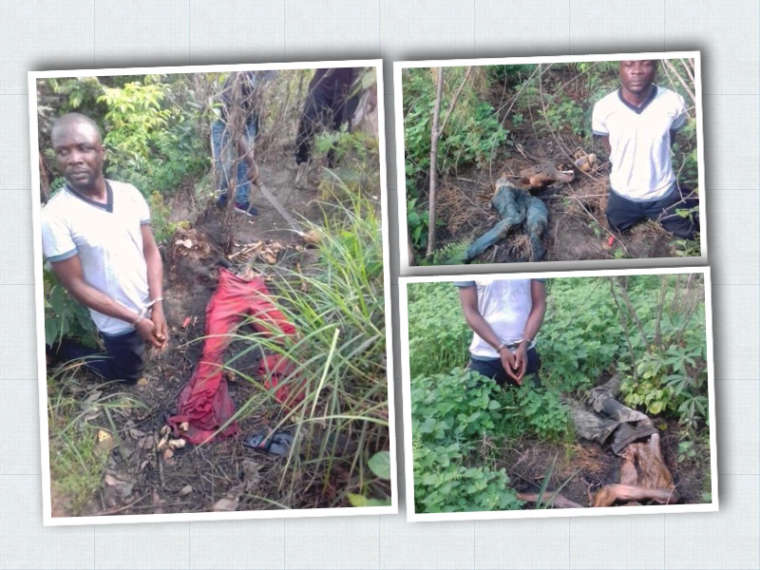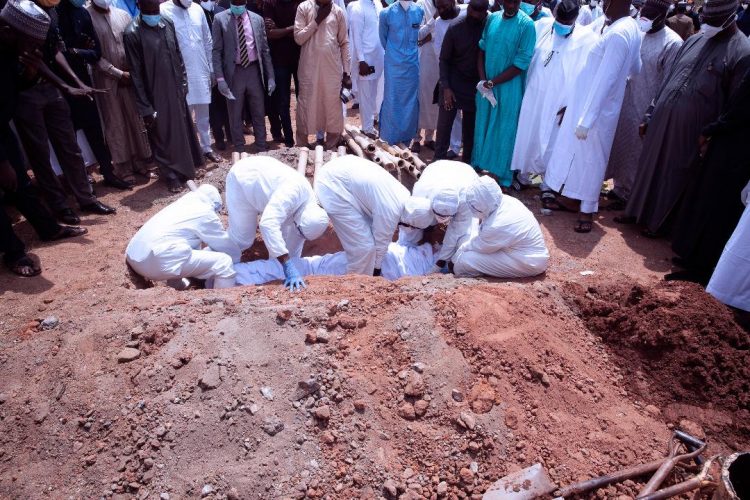Groups
-
david-manglideposted in News & Trends • read more

President Muhammadu Buhari has commiserated with the families of three University of Port Harcourt students reportedly murdered by their kidnappers and their bodies buried in a shallow grave in April.
He said the killers must be apprehended and made to face the wrath of the law.
The President also extended condolences to the university authorities and the Rivers State Government over the unfortunate incident.
Describing the tragic occurrence as “sad and heinous,” Buhari regretted that the “evil perpetrators have cut short the prospectively bright journey of these youths.”
He prayed that God would comfort all those who mourned these young students, and grant their souls eternal rest.
Buhari, while noting that the Nigerian Police Anti-Kidnapping Unit has apprehended one of the suspected perpetrators, further directed the Police Authorities to intensify search for the remaining suspects and bring them to justice.
According to the President, “This administration will continue to equip the law enforcement and security agencies to bring to an end the evil activities of kidnappers in the country.”
-
david-manglideposted in News & Trends • read more

The Central Bank of Nigeria, CBN, has ordered banks to stop any form of retrenchment of workers now.
Isaac Okorafor Director, Corporate Communications, CBN, said the apex Bankers’ Committee both decided to suspend lay-offs in banks.
The statement said that in order to help minimize and mitigate the negative impact of the COVID-19 pandemic on families and livelihoods, no bank in Nigeria shall retrench or lay-off any staff of any cadre (including full-time and part-time).”
It said the decision was taken following special meeting of the Bankers’ Committee on May 2, 2020, to further review the implications of the COVID-19 pandemic on the Nigerian banking industry.
The statement said the Committee deliberated on the issue of the operating costs of banks in view of the disruptions emanating from the global economic difficulties.
The CBN stated that at the end of the meeting, it was decided that the express approval of the Central Bank of Nigeria shall be required in the event that it became absolutely necessary to lay-off any such staff.
Access Bank had recently laid off some staff, citing economic downturn occasioned by Coronavirus lockdown as reason.
-
david-manglideposted in News & Trends • read more

Music director and producer Clarence Peters is currently being detained by Lagos police over the death of popular dancer, Love Divines known as Kodak.This happened after reports emerged that the popular dancer died at Peters’ house on Wednesday while charging her iPhone.
It was reported that the dancer was barefooted and sat near the door of the residence while operating the plugged phone when the incident happened.
According to reports, she suffered chest burns when the phone fell on her body and died before they got to the hospital.
However, The Nation reported that Peters is now being detained and questioned at the State Criminal Investigation and Intelligence Department (SCIID), Yaba.
-
david-manglideposted in News & Trends • read more

Friday Akpan, the chief suspect in the abduction and murder of three UNIPORT students has told Rivers Police Command why his gang committed the heinous crime.
Kidnapped and later killed were Joy Adoki, a 400 level student of Management, Fortune Obemba, and Nelson Nwafor.
Akpan, a member of the gang called Trouble, claimed his gang kidnapped the three students on the order of one Bright.
The latter claimed one of the victims, Nelson, betrayed him after money was paid into his account.
He didn’t state how much money Bright paid his gang.

Akpan was arrested on 30 April.
He later led the police to the arrest of two other members of the gang and the forest where they killed and buried the three students.
The forest was in Etoo in Eleme LGA.
Akpan admitted he joined in the gang-raping of Joy, but denied taking part in killing her and other two victims.
According to him, the three victims were killed when they could not pay the ransom demanded.
.
The Officer in Charge of Anti-kidnapping unit, SP Shedar Edward, said the three suspects belong to “Iceland cult” group.He said they are helping the police to rid the state of criminal elements.
Yesterday, the Rivers State Police Command exhumed the remains of the undergraduates at Etoo Forest, almost 23 days after they were abducted.
The Police Public Relations Officer,PPRO, of Rivers State Police Command, Nnamdi Omoni spoke on the efforts by the police.
‘’Men of the anti-kidnap unit swung into action and in the course of their investigation arrested one Friday Akpan who confessed to the crime and led the police to the arrest of two other accomplices”.
Omoni said one AK 47 riffle, one Pistol, three magazines,72 rounds of live ammunition were recovered from the suspects.
The Police assured that they would arrest the fleeing members of the gang.
-
david-manglideposted in News & Trends • read more

The authorities of University of Port Harcourt, UNIPORT, said two of the murdered victims of abductors in Rivers were not their students.A spokesman for the university, Dr. Williams Wodi identified the only female victim, Joy Favour Adoki, as a student.
She was a 400 level Management Science Student and lived off campus in Alakahia community in Obi-Akpor LGA, he said.
Disclaimed by the university were Nelson Nwafor and Fortune Obemba.
The bodies of the three victims of abduction were exhumed by the police on 1 May, at Eteo forest in Eleme Local Government Area.

Wodi said the university has no records of Nwafor and Obemba.
“Only the girl (Joy Favour Adoki) is a student of UNIPORT. The other two are not.
The girl is of faculty of Management Science. She resides off-campus at Alakahia,” Wodi said.
Wodi added that Adoki was expected to have been with her parents after the closure of the university.
UNIPORT, like other Federal-owned universities were shut on 20 March over COVID-19 pandemic.
Adoki and the other victims were kidnapped on 7 April.
Friday Akpan, one of the leaders of the kidnapping gang took operatives of the anti-kidnapping unit of Rivers State Police Command to Eteo Forest on 1 May.
There, the three bodies were retrieved and taken to the morgue.
They were all initially recognised as UNIPORT students.
-
david-manglideposted in News & Trends • read more

All the improperly kitted mourners at the burial 18 April of Malam Abba Kyari have tested negative to coronavirus.
Dr Mohammed Kawu, Acting Secretary, FCT Health and Human Services Secretariat, made this known in Abuja on Sunday.
Kawu said they have completed 14 days in isolation and been reunited with their families.
There was a national uproar after a video of the mourners went viral.
The video showed some of them without masks.
One of the mourners also dumped a protective suit carelessly at the burial ground in Gudu, Abuja.
Their actions breached the burial protocol outlined by the World Health Organisation and Nigeria Centre for Disease Control, NCDC.
The FCTA swiftly moved to arrest all the mourners.
Some of them, who were staff of the Presidency, were barred from coming to the office, until they completed 14-day isolation.
Abba Kyari, President Buhari’s chief of staff died in Lagos on 17 April from COVID-19 complications.
He was buried 18 April in Abuja.
-
david-manglideposted in Primary 5 • read more
Subject: Computer Education
Topic: Purpose of using Computer
Duration: 40mins
Reference Material: Basic Computer Education for the New Generation 5
Previous Knowledge: Pupils are familiar with the computer system.
Objective: At the end of the lesson, pupils should:
- State the purpose of using computer
- State professionals and what they use the computer for
Content:
Purpose of using Computer
- Performing calculations: addition of numbers, subtractions, multiplication and division e.g. Microsoft excel can be used for mathematical calculations
- Saving and storing of data
- To retrieve data
- Processing of data
- To do different task e.g. produce recording, teaching graphic, playing computer games e.t.c.
Places in the Society Where Computers can be used
- Financial institution: insurance companies, banks, stock exchange
- Public institution: they are government owned companies e.g. water corporation, PHCN, Nigeria Railway Corporation (NRC)
- Social institution: clubs, association, such as tennis club etc.
- Academic institution: they are schools e.g. college, universities, polytechnics etc.
- Private institution: they are companies established by individual or group of people in order to make profits e.g. Cadbury Nigeria ltd, GLOBACOM
Jobs
Professional Uses of the Computer
Teacher
Uses computer to teach; learn and for research
Banker
Uses computer for financial record
Pilot
To read weather condition
Farmer
To keep farm record
Medical Doctor
To diagnose patient sickness
Student
To study and make research
Secretary
Uses computer for office records and information process
Engineer
For structural designs, and for calculations
Presentation:
Step 1: Teacher revises the previous lesson with the pupils.
Step 2: Teacher introduces and explains the new topic to the pupils.
Step 3: Pupils are allowed to ask questions.
Step 4: Teacher writes notes under content on the board for pupils to copy.
Evaluation:
- Mention the purpose of using the computer
- List three places in the society where computer can be used
Conclusion: Teacher moves round for inspection, marking and correction of notes where necessary.
-
david-manglideposted in Primary 5 • read more
Subject: Agricultural Science
Topic: Pest and Diseases of Crop Plants
Duration: 40mins
Reference Material: Agricultural Science for Primary School, 5
Instructional Material: Pictures of some common pest e.g. squirrel, rat, weevil
Previous Knowledge: Pupils are familiar with common disease in livestock production.
Objective: At the end of the lesson, pupils should:
- List the categories of Pest
- Define Disease
Content:
A pest is any organism that is capable of causing damage to plants. There are different categories of pest; they are insects, pest, rodents (rat, squirrel), birds, monkeys and human pest.
Insect pest is the category of pest capable of causing the largest proportion of damage to crops. They may be categorized into two based on their mouth parts
- Chewing and biting mouth parts e.g. weevil, grasshopper
- Piercing and sucking mouth parts e.g. butterfly, mouth, cotton stainer
Disease is the alteration or deviation from normal state of health in animals or deviation from normal physiological function of the plant.
Signs/Symptoms of Disease in Plants
- Stunted growth of plants
- Poor or low yield
- Physical defeats such as poor colouration and irregular stem growth
- Premature death of plants
- Abnormal maturity of fruits.
Disease in plants are caused by parasites or unfavourable environmental conditions.
Presentation:
Step 1: Teacher revises the previous lesson with the pupils.
Step 2: Teacher introduces and explains the new topic to the pupils.
Step 3: Pupils are allowed to ask questions.
Step 4: Teacher writes notes under content on the board for pupils to copy.
Evaluation:
- What are Pests?
- Define Diseases
Conclusion: Teacher moves round for inspection, marking and correction of notes where necessary
Assignment: Agricultural science for Pry Sch, 5 Page 52, ex 4, 1 – 10
-
david-manglideposted in Primary 5 • read more
Subject: Social Studies
Topic: Wages and Income
Duration: 40mins
Reference Material: Easyway to Social Studies for Primary School, 5
Previous Knowledge: Pupils are familiar with employment.
Objective: At the end of the lesson, pupils should:
- Explain Wages
- Give reasons why some people earn high salaries
Content:
Wages and salaries are the amount of money paid to workers by their employers after the workers have done their job.
Salary differs from wages in the sense that salaries are fixed, regular and usually paid every month, while wages are paid according to the number of hours, days or weeks that a person works.
Other Incomes
In addition to salaries and wages, other income workers can get are the following:
- Transport allowance
- Interest from saving
- Housing allowance
- Gratuity
- Dividends
Reasons why some workers receive higher salaries than others
- A very big company/industry pays higher salary than smaller ones
- Workers who do delicate work (doctors) or dangerous works (pilot) often receive more salary than those who do normal work.
- A person with higher qualification
- Those who do their work better gets a higher pay
- Those who do more work than others
Effects of Unequal Wages and Salaries
- They stage a demonstration o they go on strike
- They may protest by writing to their managers to complain
- They may work without giving their best, because they are unhappy
- They might decide to resign
Presentation:
Step 1: Teacher revises the previous lesson with the pupils.
Step 2: Teacher introduces and explains the new topic to the pupils.
Step 3: Pupils are allowed to ask questions.
Step 4: Teacher writes notes under content on the board for pupils to copy.
Evaluation:
- List four other types of income that workers can get
- State the difference between wages and salary
Conclusion: Teacher collects notes for correction and marking.
Assignment: State reasons why people collect different salaries
-
david-manglideposted in Primary 5 • read more
Subject: Bible Knowledge
Topic: Jesus leads us to the Father
Duration: 40mins
Reference Material: Christian Religious Knowledge for Primary School, 5
Instructional Material: Luke 10:22, John 3:16-17; 10:11-18.
Previous Knowledge: Pupils are familiar with Jesus the son of God
Objective: At the end of the lesson, pupils should:
- List the roles of Jesus in our lives
- Explain why Jesus is called the Good Shepherd
Content:
Jesus is the son of God who became man for our sins “For God so loved the world that He gave His only Son, that whosoever believes in Him will not perish but have eternal life. God sent Jesus to the world so we might be saved through Him.
Jesus is capable of leading us to the Father. He says that “I am the door, if anyone enters by me, he will be saved, and will go in and out and find pasture (John 10:9)”.
Jesus was tried and condemned because of our sins in order for us to be saved. Anything we ask for in the name of Jesus will be given to us by God the Father because the name is the name above all names.
Jesus is the Good Shepherd, He protects His sheep from the attack of robbers and danger. As a Good Shepherd, Jesus knows those who believe in Him and He cares for them. He knows the Father and the Father knows Him. He tells us that He and the Father are one. He will give eternal life to anyone who follows Him.
Moral Lesson
- God demonstrated His love to us by giving us Jesus, we should in return give ourselves in service unto God through Jesus Christ.
- Just like Jesus is the Good Shepherd, we should also be good followers of His.
- We must pray to the Father through His Son, Jesus Christ.
Presentation:
Step 1: Teacher revises the previous lesson with the pupils.
Step 2: Teacher introduces and explains the new topic to the pupils.
Step 3: Pupils are allowed to ask questions.
Step 4: Teacher writes notes under content on the board for pupils to copy.
Evaluation:
- Jesus became a man in order to ____________________
- List two moral lessons from the lesson “Jesus leads us to the Father”
Conclusion: Teacher moves round for inspection, marking and correction of notes where necessary.